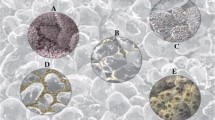Abstract
Permeability is one of the most important parameters of reservoir rocks, it illustrates the capacity of rock to transmit fluids (oil, gas, water) in pore spaces. Permeability data can be obtained from routine core analysis in laboratory on 1.5 in core plugs and sidewall core. However, most of the wells are not coring due to problems during coring and higher costs, so permeability prediction in uncored sections play a significantly important role. The variety of methods developed to estimate permeability at pore scale, such as Kozeny–Carman, Swanson and Pittman. In fact, those equations are applied individually to estimate permeability. In this research, permeability estimation methods will be used on the same rock (sandstone or carbonate rock) to detect the suitable method for each rock type. Porosity, permeability data from routine core analysis and pore throat size from mercury injection capillary pressure on sandstone and carbonate rocks from Cuu Long and Song Hong basins in Vietnam will be gathered and permeability estimation conducted by using Hydraulic Flow Unit, Mercury Injection Capillary Pressure and Pittman methods based on that data. Estimated permeability obtained from each method will be compared with core permeability, the method with the highest R-squared be selected. The research shows that Hydraulic Flow Unit is optimized method for permeability prediction on sandstone with R-squared > 0.9. Mercury injection capillary pressure is the most accurate method to estimate permeability on carbonate rocks related to heterogeneity and complicated pore system with R-squared > 0.96. That results will help engineers have a fast and accurate decision for permeability prediction methods selection on sandstone and carbonate rocks. In addition, the empirical equations were derived to predict permeability on sandstone and carbonate rocks with the highest coefficient of correlation in multiple regression analysis and based on the relationship between porosity, permeability and pore throat size.

















Similar content being viewed by others
Abbreviations
- ∅e :
-
Effective porosity, (%)
- ∅z :
-
Pore volume to grain volume ratio
- rmh :
-
Mean hydraulic radius, (μm)
- τ:
-
Tortuosity
- Fτ2 :
-
Kozeny constant
- Sgv :
-
Surface area per unit grain volume, (μm−1)
- Pc :
-
Capillary pressure, (psia)
- \(\sigma\) :
-
Interfacical tension of mercury, (dynes/cm)
- θ:
-
Contac angle between mercury and the pore surface, (°)
- rc:
-
Pore throat radius, (μm)
- Rapex:
-
Pore radius corresponding to the apex, (μm)
- k:
-
Permeability, (md)
- ∅:
-
Porosity, (%)
References
Amaufule JO, Altunbay M, Tiab D, Kersey DG, Keelan DK (1993) Enhanced Reservoir description: using core and log data to indentify hydraulic (flow) units and predict permeability in uncored intervals/wells”, paper SPE 26436 presented at the 1993 SPE annual technical conference and exhibition, Houston, Texas, October 3–6.
AutoPore IV 9500 (2001) Automated Mercury Porosimeter Manual, Micrometitics. Operation’s Manual, V 1.04
Ebanks WJ, Tye RS, Ranganahan V (1984) Geological factor influencing reservoir performance of the hartzog draw field, wyoming. J Pet Technol 36:1335–1344
Pittman ED (1992) Relationship of porosity and permeability to various parameters derived from mercury injection-capillary pressure curves for sandstone. AAPG Bulletin 76:191
Pittman ED (2001) Estimating Pore Throat Size in Sandtones from Routine Core Analysis Data. Search and Discovery Article 40009:20
Shafer J, Neasham J (2001) Mercury porosimetry protocal for rapid dertermination of petrophysical and reservoir quality properties. Reservoir Management Group, Poro Technology, Houston
Washburn EW (1921) Note on a method of determining the distribution of pore sizes in a porous material. Proc Natl Acad Sci 7:115
Acknowledgements
The authors would like to thank the manager of Core and PVT Department (Vietnam Petroleum Institute) for supporting this research.
Author information
Authors and Affiliations
Corresponding author
Rights and permissions
About this article
Cite this article
Ngo, V.T., Lu, V.D. & Le, V.M. A comparison of permeability prediction methods using core analysis data for sandstone and carbonate reservoirs. Geomech. Geophys. Geo-energ. Geo-resour. 4, 129–139 (2018). https://doi.org/10.1007/s40948-017-0078-y
Received:
Accepted:
Published:
Issue Date:
DOI: https://doi.org/10.1007/s40948-017-0078-y




